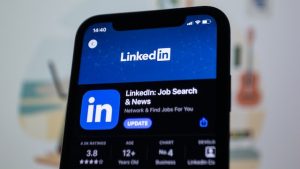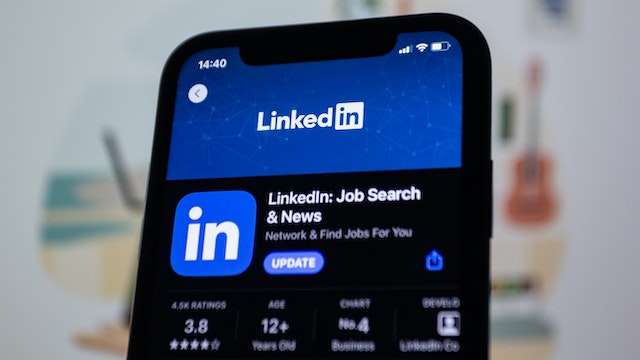Connecting with business buyers and other professionals, LinkedIn is the most important business-to-business (B2B) social media platform (and increasingly in content marketing).
Relationships can be formed, thought leadership can be established, leads can be generated, insights can be gained, market research can be conducted, Reputation can be enhanced, and online communities can be created, all thanks to the network.
8 Reasons Linkedin is Important for Your Business:
- Create Awareness and Improve Reputation
- Thought Leadership and Influencer Marketing
- Selling and Generating Leads
- Social CRM
- Traffic Building
- Generate Genuine Qualified Leads
- Power of Linkedin Pulse
- Leverage Linkedin Groups

Photo by Bastian Riccardi: https://www.pexels.com/photo/marketing-smartphone-internet-connection-15406295/
1. Create Awareness and Improve Reputation:
LinkedIn is a great way to raise your profile and gain exposure online. As more than two new professionals join LinkedIn every second, companies have a greater chance of connecting with influential individuals. Using LinkedIn’s various personal and group capabilities, businesses and the people who represent them can raise their profile and credibility among their target audiences.
Thanks to the redesign, an unused feature that is now more prominently displayed on the site is the ability to post status updates.
2. Thought Leadership and Influencer Marketing:
Several LinkedIn tools help you establish yourself as an authority in your field. Thought and practice leaders who want to become trusted advisers might find a fruitful environment on LinkedIn by contributing high-quality content, enhancing their profile, engaging in LinkedIn communities, and answering inquiries.
Respect and authority are inextricably linked concepts. Since making connections is LinkedIn’s primary function, the platform lets you find and connect with influential people.
3. Selling and Generating Leads:
LinkedIn is the greatest network to use if you want to produce leads. In addition to more conventional methods, like promoting downloadable information and sending traffic to relevant sources, LinkedIn provides highly personalized approaches to finding leads, engaging them, and ultimately converting them into customers.
Getting the most out of listening, thinking, taking part, sharing, networking, and giving feedback. Indirect marketing and networking on LinkedIn can help bring in more customers.
B2B marketers can find new leads by sifting through the 18% of posts relevant to groups and the problems and concerns they raise there. Also, another 18% are giving you insight into their interests through content sharing and enjoying.
Answering questions on LinkedIn is a great way to show off your expertise. Customers will reach out to you if the problem you solve or the question you answer is one they have been trying to find.
4. Social CRM:
For social customer relationship management, LinkedIn is great because it improves our understanding of contacts and consumers. The simplest Social CRM apps can accomplish this, but ‘connectors,’ such as those for Outlook, can be helpful.
LinkedIn supports Google Contacts; thus, even if your Social CRM system doesn’t integrate with LinkedIn, you can still build up a rudimentary integration of your contacts.
If you use a social CRM platform, you can monitor your contacts’ activity on LinkedIn in real-time, providing useful insight into their habits and preferences. Targeting a specific connection on LinkedIn grants access to their profile in its native setting.
5. Traffic Building:
LinkedIn’s expertise in generating links and website visitors is an underappreciated advantage. Similarly to other social networks, LinkedIn allows you to share material in your status updates (displayed on the homepage) and in LinkedIn Groups (groups) that you are a part of, employing a social sharing button.
This is a great strategy for business-related content and can even have a viral effect. LinkedIn has become the preferred social media platform for disseminating business-related content, surpassing even Facebook.
6. Generate Genuine Qualified Leads:
LinkedIn is one of the best social media platforms to use when looking for qualified leads. LinkedIn may also be used to personally identify potential leads, engage them, and convert them into customers or clients, putting out educational information and increasing traffic to your website.
To achieve this goal, one must practice striking a harmonious balance between listening, analyzing, participating, sharing, networking, and replying. Because it allows you to network with new clients and market to them directly effortlessly, LinkedIn can help you easily grow sales.
7. Power of Linkedin Pulse:
LinkedIn Pulse lets users publish short articles on the network’s microblogging platform. As a result, you can increase your authority, attract more people, and establish yourself as an authority in your field. Every user’s Pulse feed is personalized to reflect the stories and relevant information.
Professionals at all levels and in various industries will be exposed to your writing content. When you make a post on LinkedIn, your connections will be alerted. That way, a sea of others won’t bury your messages.
8. Leverage Linkedin Groups:
Using LinkedIn groups is a terrific method to connect with other powerful businesspeople and network with potential clients. LinkedIn allows you to not only join preexisting groups but also to start your own. Interacting with other influential people in your field and related fields is facilitated by joining groups.
These communities are great places to network with individuals who share your interests and gain insight from thought leaders in your field. LinkedIn Announcements allow you to reach out to the group’s members by email.

